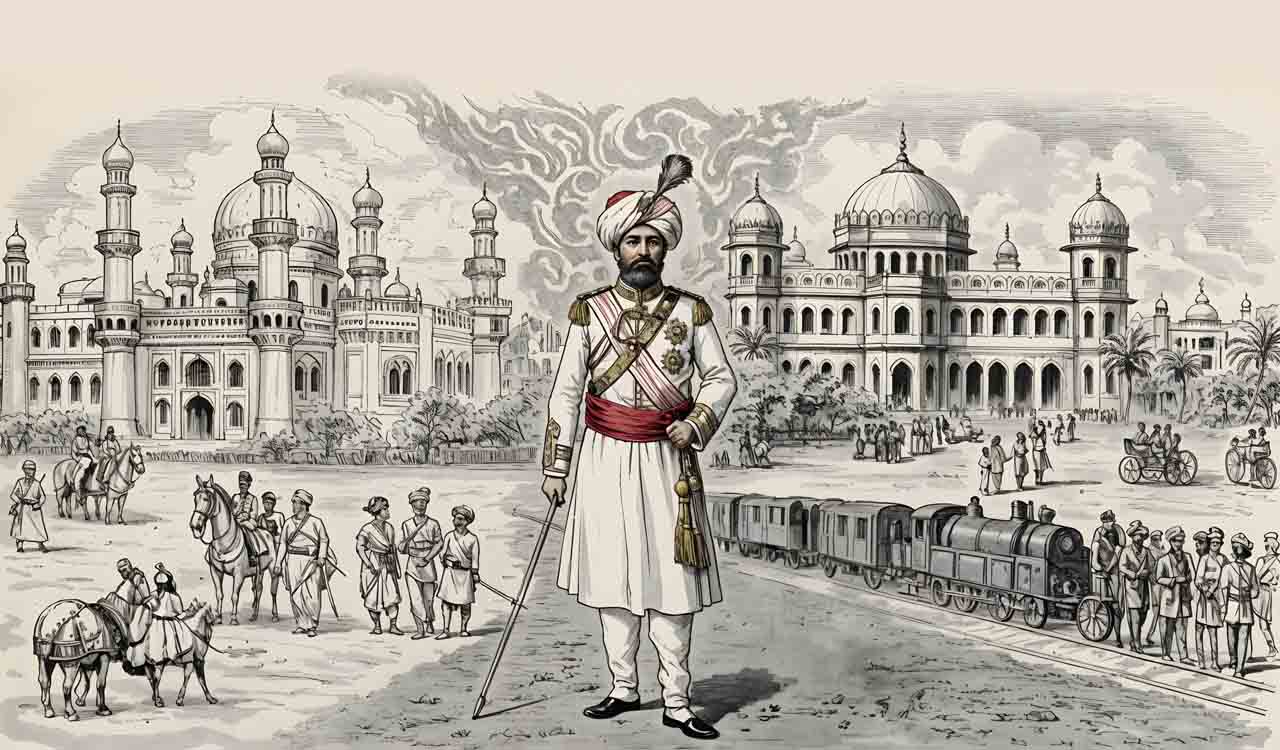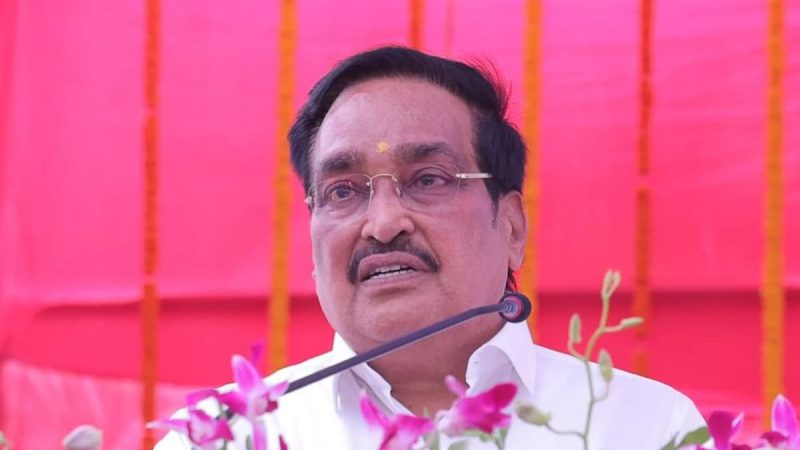Rewind: Maker of modern Hyderabad

The period of Sir Salar Jung I from 1853 to 1883, a watershed moment in the history of Hyderabad State, saw the feudal princely State metamorphosed into a progressive, forward-looking administrative unit
Published Date – 3 May 2025, 08:08 PM

By KSS Seshan
The history of Hyderabad under the Asaf Jahis will never be complete without an understanding of the life, career and services of the enigmatic Sir Salar Jung I, who served as the Diwan under three successive Nizams spanning over three decades. He rightly deserves the credit for metamorphosing Hyderabad State from a custom-bound feudal princely State into a progressive, modern and forward-looking administrative unit. He pulled the Hyderabad State from Medievalism to Modernism through a slew of administrative reforms.
The period of his prime ministership from 1853 to 1883 is a watershed in the history of Hyderabad State and is rightly hailed as the Era of Salar Jung. Regrettably, there is no memorial or monument to commemorate his services. Ironically, the name Salar Jung is remembered in connection with the iconic museum in Hyderabad that houses the art and artefacts of his grandson, Mir Yousuf Ali Khan — Salar Jung III.
Salar Jung’s family originally belonged to Arabia. It moved to India and served the Adil Shahis of Bijapur, then the Mughals and finally the Nizams of Hyderabad. The family produced as many as five Diwans — two before him, his grandfather Munir-ul-Mulk and his uncle Siraj-ul-Mulk, and two after him, his son Liak Ali Khan and grandson Yousuf Ali Khan. But Salar Jung was by far the most distinguished representative of the family, becoming the Diwan when he was merely 24 the death of Siraj-ul-Mulk in 1853.
An Early Start
Salar Jung was born on 21 January 1829, and his early name was Thurab Ali Khan. His father, Shuja-ud-Daula, died when he was hardly 2 years and, therefore, he was brought up by his grandfather and uncle. His public life began in 1847 when, at 18, he was appointed as a Talukdar (District Collector) of Khammam. He soon came to be known as an upright and honest officer.
Regrettably, there is no memorial or monument to commemorate Salar Jung’s services, and ironically, the name is remembered in connection with the iconic Museum in Hyderabad that houses art and artefacts of his grandson, Mir Yousuf Ali Khan — Salar Jung III
In May 1853, Salar Jung was appointed the Diwan by the Nizam, Nasir-ud-Daulah. His powers as the Prime Minister reached a high-water mark when he was appointed, additionally, as the Regent to the infant Nizam Mir Mahaboob Ali, who succeeded his father Afzal-ud-Doulah in 1869. Most of the far-reaching reforms for which Salar Jung is well-known were initiated during this period of Regency from 1869, when he enjoyed greater autonomy. His daughter, Amat-uz-Zehra Begam, was married to the Nizam Mahaboob Ali, and of the union was born Mir Osman Ali Khan, the last of the Nizams.
Administrative Reforms
The state of affairs in Hyderabad before Salar Jung is well illustrated by Chiragh Ali when he wrote:
Before the administration of H.E. Nawab Salar Jung I, there was no regular or systematic form of government, nor were there any separate departments of administration. Everything was in the hands of the Diwan or Minister, without any regular form of administration. It was altogether a new idea, an element foreign to the conservative mind of Hyderabad to have anything like an organised system of government.
In 1867, the State was divided into five divisions or Subhas; Subhas were divided into Districts, known as Zillas. There were altogether 14 Districts. Known as Zillabandi, the district administration became the bedrock of Salar Jung’s reforms. Each district was again subdivided into Taluks, and by 1880, there were 107 Taluks in the State.
Salar Jung abolished the obnoxious system of farming revenue, and officers were paid salaries in cash. He also reduced the number of Jagirs where no valid rights existed. By 1880, many departments like the Judiciary, Revenue, Police, and PWD came up. Railways and Telegraphs were also created. Like in the Madras Presidency, Salar Jung appointed the Inam Commission in 1875. The Survey and Settlement Department was established to survey land, fix boundaries and check soil before assessing the land tax. For Hyderabad, a separate Police Commissioner called Kotwal was appointed to ensure law and order.
After Sir Salar Jung’s visit to England, Hyderabad was never the same as before — not only English education but also English customs, manners, and dress made their way into the elite circles; buildings had a touch of modern European architecture
The first Judicial Secretariat was established under the Diwan. Separate courts were set up at the District and Taluk levels. Salar Jung reformed the Police establishment, and in each District, a superintendent was appointed. Each Taluk also had a police officer to maintain law and order, and training for police officers became mandatory. In 1881, a Stamp Paper office was established in Hyderabad. As a result of the reforms, the annual income of the State exceeded the expenditure manifold.
Educational Progress
The modern system of education in Hyderabad owes its origin to Salar Jung. This is not to say that he left it in a highly flourishing condition, but that before him even the elements of the modern educational system were lacking. Darul-Uloom or Oriental College came up in Hyderabad in 1854 with Arabic and Persian as mediums of instruction. An educational Board, attached to the Revenue department, was constituted in the same year to look after the needs of the Oriental College.
Encouraged by the success of Darul Uloom, the Nizam’s government in 1860 established two schools — one in Vernacular and another in Persian — in every district and Taluk headquarters. WH Wilkinson, a British educationalist who was the Principal of the Engineering College, was appointed as Secretary for Education and the first Director of Public Instruction in 1869. His successor, Moulvi Inayat-ur-Rahman, also initiated reforms such as introducing new curricula and raising the standard of teaching.
In 1878, Salar Jung set up Madarsa-i-Aliya for the education of his sons and the sons of other nobles in the city. Foreign scholarships were awarded to students for higher studies abroad. They were also offered employment in government service. Salar Jung’s nephew Mukarram-ud-Daulah, who studied in Madarsa-i-Aliya, set up Madarsa-Aiza in 1878 exclusively for the education of the upper classes.
A few years after the death of Salar Jung, the Nizam College was established in 1887 by merging the Intermediate classes of the Chaderghat High School with Madarsa-i-Aliya. Nizam College was affiliated to Madras University. At the end of Salar Jung’s period, there were 162 schools in the Diwani (directly administered) territory of the Nizam, of which 13 were in the city. Of the total schools, 105 were Persian schools, 35 Marathi, 19 Telugu and 3 English. The expenditure on education during 1883, the year when Salar Jung passed away, was Rs 2 lakh.
Though it is well-known that renowned social reformer, educationalist and politician Sir Syed Ahmed Khan was the founder of the Aligarh movement with the establishment of the Mohammedan Anglo-Oriental College (MAO) that would become the Aligarh Muslim University, what is less known is how he left an indelible mark on the administration, education and the cultural life of Hyderabad State and Salar Jung.
In May 1873, Salar Jang had asked Sir Syed to suggest experienced Indians who could handle matters like Justice, Revenue and Education in Hyderabad State. Maulvi Mehdi Ali, a close associate of Sir Syed, was the first person to be appointed in 1874 in Hyderabad. Another nominee of Sir Syed who came to Hyderabad was Maulvi Mustaq Ahmed Hussain. He attracted the attention of Syed Ahmed Khan during the famine of 1861 when he supervised the relief works in Moradabad in Uttar Pradesh. Mushtaq worked in Hyderabad State for nearly 17 years from 1874 and held several high positions. He prepared comprehensive plans for the distribution of relief during famines.
The third important nominee of Sir Syed was Maulvi Chiragh Ali. A lifelong associate and a solid supporter of his Aligarh movement, Chiragh Ali made a mark as an able administrator in Hyderabad State.
There were a few more educationalists who came from other parts of India, though they did not belong to the following of Sir Syed. Maulvi Sayed Hussein Bilgrami was one such. He came to Hyderabad in 1873 on Salar Jung’s invitation and became his private secretary. In 1876, he accompanied Salar Jang to England and later became one of the tutors for the young Nizam Mir Mahaboob Ali. Bilgrami was also associated with Nizam College. He became a member of the India Council in 1910 and worked closely with Lord Morley, the Secretary of State for India.
Halli Sikka, Hyderabad’s currency
One of Salar Jung’s significant contributions was the introduction of a new currency. In 1855, he established a State Bank in Hyderabad city and introduced a silver currency — Halli Sikka. A central Mint was established in the capital, and the district mints as well as the mints by the Samsthanas were abolished. The government treasury was established in Hyderabad, and the Customs department was taken over by the government. By 1868, the government of India also adopted the Halli Sikka as the Rupee for Hyderabad and fixed the official rate of exchange between it and the British Government Rupee at 16-14. There was no paper currency at that time in Hyderabad. Salaries to the government employees were paid in coins. A British visitor, John Law, narrates an interesting anecdote when he came across a government officer walking with a large bag in each hand. When asked what made him bend and sway, his reply was “My salary”.
Railways in Hyderabad
It was during Salar Jung’s administration that the British succeeded in pushing through the Railways in Hyderabad. They approached the Nizam’s government with a proposal to build a railway line to Hyderabad by the Great Indian Peninsular (GIP) Railway company. It was also stipulated that Hyderabad State was to pay a guaranteed interest to the GIP. Finally, an agreement was signed between the British and the Nizam’s government in May 1870.
The Wadi-Secunderabad section, the first Railway Line in the Hyderabad dominions with a length of 192 km, was opened with great fanfare on 8 October 1874. The next line, the Secunderabad-Warangal section with a length of 140 km, was opened on April 8, 1886.
English Touch
Salar Jung I visited England at the personal invitation of the Prince of Wales, who had earlier visited Hyderabad. In April 1876, Salar Jung, with a large entourage consisting of his advisers, officials and personal staff numbering 52, set sail to England from Bombay. On the way, he called on the King of Italy, Victor Emmanuel II. A few days later, he had an audience with the Pope. After visiting Venice, Naples and Florence, they reached London.
At a specially held commemorative ceremony, Oxford University conferred a DCL (Doctor of Civil Laws) on Sir Salar Jung. No other Minister of a native State in India by then had such an honour from Oxford. Sir Salar Jung was received by Queen Victoria at Windsor Castle on 3 July, where, after the banquet, he stayed back for the night. This was probably the only occasion when a non-royal, like Salar Jung, ever stayed at this centuries-old British Royals’ private residence, the Windsor. Queen Victoria also invited him to dine at Buckingham Palace.
The Town Council of London, in a glittering ceremony held at Guildhall on July 25 conferred the honorary Freedom of the City, London, on Salar Jung. After more than two months in England, he left for home on 31 July.
After Salar Jung’s visit to England, Hyderabad was never the same as before. Not only English education but also English customs, manners, dress, and even Western etiquette started creeping into the elite circles of Hyderabad. The flamboyant young Nizam Mahaboob Ali Pasha took to a signature dress that was highly influenced by the West, and his wardrobe, considered the largest in the world, was fed by an army of tailors directly brought from England. Several houses and public buildings in Hyderabad and Secunderabad came up with modern European architecture.
As a loyal Prime Minister, Sir Salar Jung I was to the Nizam what Otto von Bismarck was to Kaiser Wilhelm in Germany. Like Richelieu and Mazarin, who served the Bourbon kings, Louis XIII and Louis XIV of France as Prime Ministers in the 18th century, Salar Jung showed great sagacity and administrative acumen and saved the State from anarchy and maladministration. He rightfully earned the title of “the greatest Prime Minister of any Princely State in British India.”

(The author is a retired Professor of History, University of Hyderabad)






